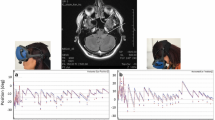Summary
In the last few years, we have studied ocular reflexes caused by tilting stimulations in test subjects placed in an upright sitting position on a chair apparatus which tilts continuously. In healthy persons, a weak nystagmus can be observed, and involves a nystagmus of minor amplitude and showing a small number of beats. The actual incidence of nystagmus in the younger group was minimal, but it tended to increase with age. This occurrence is considered to be due to age-related degeneration of the otolithic organ. Patients with vertigo and/or dizziness clearly develop nystagmus. These responses are classified as follows: type I is of fixed direction; type II is of changed direction; and type III is a combination of the first and second types. Among the peripheral vestibular disorders, particularly involving those patients with benign paroxysmal positional vertigo, a nystagmus of changed direction was found. This type was rarely seen in patients with other vestibular disorders, but was a common occurrence in healthy individuals who readily experienced motion sickness. These observations have led us to conclude that patients with benign paroxysmal positional vertigo have definite reactions which are similar to those of individuals with motion sickness, and that such depends on the susceptibility of the otolithic organs.
Similar content being viewed by others
References
Aschan G (1958) Different types of alcohol nystagmus. Acta Otolaryngol (Stockh) [Suppl] 140:69–78
Bárány R (1906) Über die vom Ohrlabyrinth ausgelöste Gegenrollung der Augen bei Normalhörenden, Ohrenkranken und Taubstummen. Arch Ohrenheilkd 68:1–30
Bergstedt M (1961) Studies of positional nystagmus in the human centrifuge. Acta Otolaryngol (Stockh) [Suppl] 165: 1–144
Cawthorne TE, Hallpike CS (1957) A study of the clinical features and pathological changes within the temporal bones, brainstem and cerebellum of an early case of positional nystagmus of the so-called benign paroxysmal type. Acta Otolaryngol (Stockh) 48:89–105
Haas E (1964) Zur Frage der Altersabhängigkeit der Drehreizschwelle. Z Laryngol Rhinol Otol 43:238–246
Jongkees LB, Philipszoon AJ (1963) The influence of position upon the eye-movements provoked by linear acceleration. Acta Otolaryngol (Stockh) 56:414–419
Kanzaki J (1975) New device for measurement of ocular countertorsion reflex. Arch Otorhinolaryngol 211:213–215
Shirabe S (1967) Studies on caloric nystagmus under weak centrifuge in human with reference to the otolithic function. Otologia Fukuoka [Suppl] 13:90–100
Taborelli G, Salami A, Jankowska B (1977) Wechselbeziehungen zwischen PAN (Alkohol-Lagenystagmus) und dem vestibulären Drehbeschleunigungsnystagmus. Minerva Otorinolaringol 27:141–150 [Zentralbl 121(5): 464]
Takeda T, Kitahara M (1985) Testing of otolith function. Acta Otolaryngol (Stockh) [Suppl] 419:86–90
Author information
Authors and Affiliations
Rights and permissions
About this article
Cite this article
Shirabe, S., Soda, T., Kawano, M. et al. Eye movements induced by lateral tilt and testing of otolithic function. Arch Otorhinolaryngol 243, 153–157 (1986). https://doi.org/10.1007/BF00470610
Received:
Accepted:
Issue Date:
DOI: https://doi.org/10.1007/BF00470610



